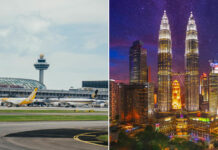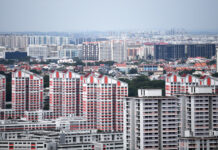SINGAPORE: Travellers passing through Tuas Checkpoint on Friday (Jan 24) afternoon thought the protective measures rolled out in response to the spread of the Wuhan virus were a breeze.
Temperature scanners have been set up at the entrance of the customs area. Travellers taking the bus only have to walk past these machines as they head to the immigration counters.
A masked traveller who has just cleared baggage screening at Tuas Checkpoint on Jan 24, 2019. (Photo: Try Sutrisno Foo)
Mr Zheng Pei Nan, 75, was travelling from Malaysia with his family. He told CNA he was not bothered by the scanners, part of the Mass Fever Screening System.
“It wasn’t inconvenient to pass the scanners after alighting from the bus,” he said in Mandarin, adding that the family only comes to Singapore once a year.
READ: Wuhan virus: Temperature screening begins at Woodlands, Tuas and sea checkpoints
READ: Wuhan virus outbreak – At a glance
He told CNA that he was aware of the virus but was not worried because he rarely travels to faraway countries.
Mr Li Jian, a tourist from Changsha, Hunan Province in China, said he did not notice the scanners at first, but lauded them as a good idea.
“It’s important to protect yourself and take your own measures,” he said.
A masked traveller being screened by a security officer with a handheld metal detector at Tuas Checkpoint. (Photo: Try Sutrisno Foo)
The 50-year-old, who will be travelling around Singapore and Malaysia for six days, said he was not worried about catching the virus in Singapore.
“Singapore is a developed country,” he said.
MORE DELAYS EXPECTED FOR THOSE TRAVELLING BY CAR
According to the Immigration and Checkpoints Authority, screening measures for visitors arriving by car will ready by Friday night. Those for motorcycles, lorries and trains will be rolled out progressively, said Superintendent Joe Tan, who is deputy commander of ground operations at Tuas Checkpoint.
Visitors arriving by car will have to roll down their windows to allow healthcare assistants to use Forward-Looking Infra-red Radar thermometers to check their temperature, he said.
A masked traveller in the immigration queue at Tuas Checkpoint on Jan 24, 2019. (Photo: Try Sutrisno Foo)
Those who have a temperature of 38 degrees Celsius and above will be taken to a holding area, where a nurse will interview them about their travel history and who they have been in contact with.
Depending on the patient’s answers, a doctor may carry out further checks to determine whether he or she is a suspected case and should be taken to the hospital. While waiting for the ambulance, the individual will be isolated and quarantined in another room.
READ: Wuhan virus in Singapore – What we know about the confirmed cases
READ: Wuhan virus in Singapore – What can you do?
If the individual arrived by car, their vehicle and travel partners will also be moved to a holding area and further assessment will be carried out, said Superintendent Tan.
As for affected individuals who arrive by bus, the people travelling with the suspected case are not treated as contact cases until the case is confirmed, said Associate Professor Vernon Lee, director of communicable diseases at the Ministry of Health.
A child adjusting his mask at Tuas Checkpoint on Jan 24, 2020. (Photo: Try Sutrisno Foo)
“We will only initiate the contact tracing proper, to label someone as a close contact, if the initial suspect case turns positive and it then becomes a confirmed case,” he said.
“For suspect cases they are still (treated as) suspect. There are quite a number of suspect cases and we don’t perform aural (ie phone) contact tracing or any other measures on individuals travelling with the suspect cases.”
According to an ICA news release on Friday morning, the screening was implemented in anticipation of increased travel volume leading up to the Chinese New Year holidays.
Due to the festive period, travel volume is expected to increase and there will naturally be delays, said ICA. During the year-end festive period in 2019, Tuas and Woodlands Checkpoints collectively saw about 475,000 visitors per day.
An advisory issued by Singapore’s health ministry at Tuas Checkpoint advising travellers who have recently travelled to China and are unwell to seek medical attention. (Photo: Try Sutrisno Foo)
While there will be minimal delays for those who arrive by bus because visitors can just walk by the temperature scanners, visitors arriving by car can expect delays because of the additional measures, said Superintendent Tan.
The delay will depend on how many individuals there are in the car.
“We’ll have to seek citizens’ understanding that there will be delays because it is an additional check that has been put in place,” he added.
Nurses are on standby at Tuas Checkpoint to receive and isolate any passengers with fever. (Photo: Try Sutrisno Foo)
Temperature screening also started at noon at Singapore’s sea checkpoints, said the Maritime and Port Authority of Singapore (MPA) in response to CNA queries.
Singapore authorities had announced on Thursday that border screening would be expanded to all land and sea checkpoints, while a travel advisory has been expanded for Singaporeans to avoid travelling to Hubei province, where Wuhan city is located.
Nurses on standby in the holding area where passengers detected with a fever at Tuas Checkpoint will be sent to. (Photo: Try Sutrisno Foo)
Health advisories have also been put up at the land and sea checkpoints to advise travellers on the precautions they are to take, especially when traveling to or arriving from China.
Singapore confirmed its first case of the Wuhan virus on Thursday evening – a male Wuhan resident, 66, who arrived in Singapore with his family on Jan 20. He is currently in isolation at the Singapore General Hospital and is in stable condition.
Two more people were confirmed to have the virus on Friday afternoon, including the 37-year-old son of the first confirmed case.
For full coverage and latest developments on the Wuhan virus outbreak: https://cna.asia/wuhan-virus
Additional reporting by Zhaki Abdullah




